AUDI A5 CABRIOLET 2013 Owners Manual
Manufacturer: AUDI, Model Year: 2013, Model line: A5 CABRIOLET, Model: AUDI A5 CABRIOLET 2013Pages: 290, PDF Size: 72.35 MB
Page 231 of 290
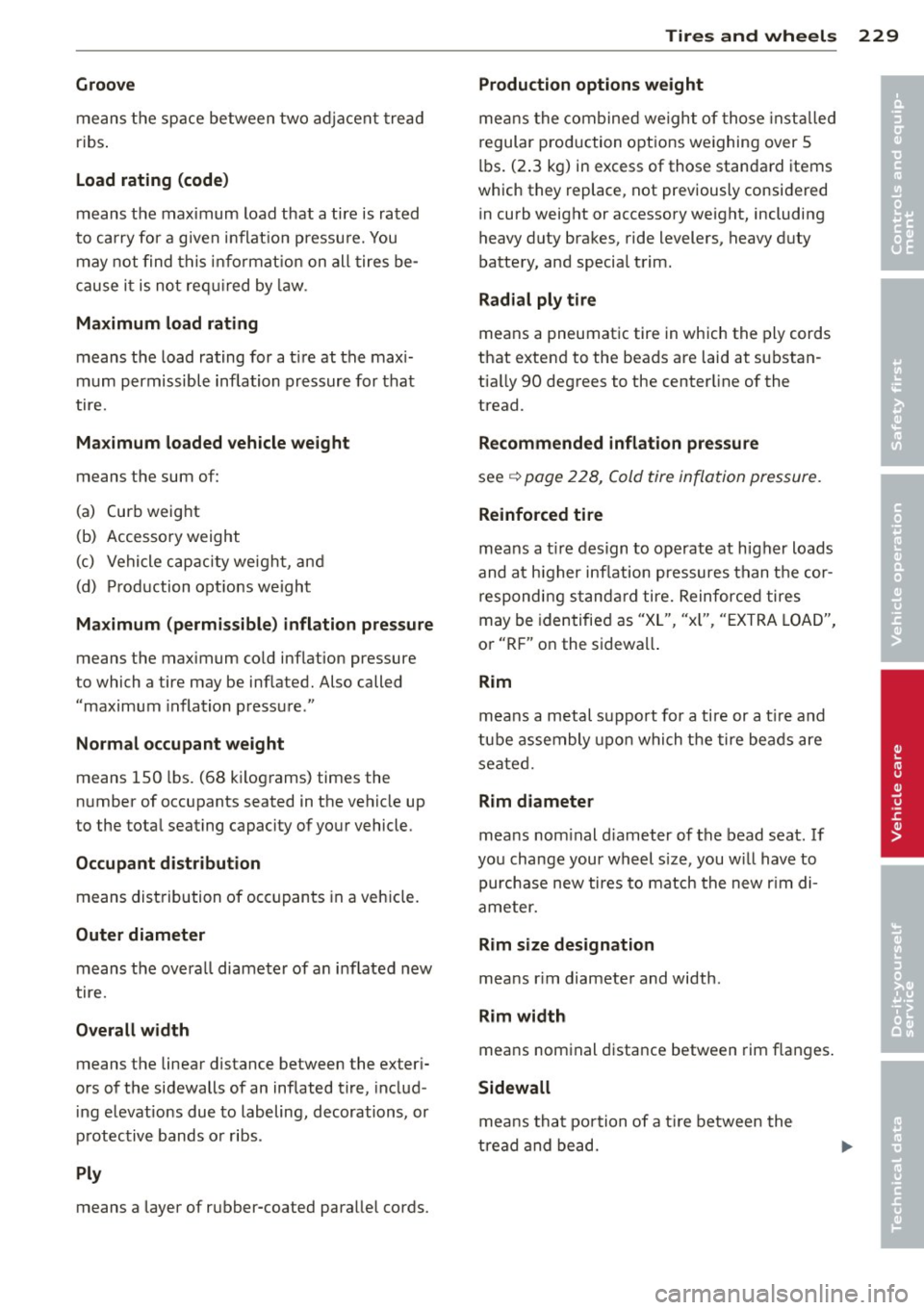
Groove
means the space between two adjacent tread
ribs.
Load rating (code)
means the maximum load that a tire is rated
to carry for a given inflation pressure. You
may not find this information on all tires be
cause it is no t req uired by law.
Maximum load rating
means the load rating for a t ire at the max i
mum permissible inflation pressure for that
tire.
Maximum loaded vehicle weight
means the sum of:
(a) Curb weight
(b) Accessory weight
(c) Vehicle capacity weight, and
(d) Production options weight
Maximum (permissible) inflation pressure
means the maximum cold inflation pressure
to which a tire may be inflated. Also called "maximum inflation pressure."
Normal occupant weight
means 150 lbs. (68 kilograms) times the
number of occupants seated in the vehicle up
to the total seating capacity of your vehicle.
Occupant distribution
means distribution of occupants in a vehicle.
Outer diameter
means the overa ll diamete r of an inflated new
tire.
Overall width
means the linear distance between the exteri
ors of the sidewalls of an inflated tire, includ
in g elevations due to labeling, decorations, or
protective bands or ribs.
Ply
means a layer of rubber-coated parallel cords.
Tires and wheels 229
Production options weight
means the combined weight of those installed
regular production options we ighing over 5
lbs. (2.3 kg) in excess of those standard items
which they replace, not previously considered
in curb weight or accessory weight, including
heavy duty brakes, ride levelers, heavy duty
battery, and special trim.
Radial ply tire
means a pneumatic tire in wh ich the ply cords
that extend to the beads are laid at substan
tia lly 90 degrees to the center line of the
tread .
Recommended inflation pressure
see¢ page 228, Cold tire inflation pressure.
Reinforced tire
means a t ire design to operate at higher loads
and at h igher inflation pressures than the cor
re sp onding standard tire. Reinforced tires
may be identified as "XL", "xl", "EXTRA LOAD",
or "RF" on the sidewa ll.
Rim
means a metal support for a tire or a tire and
tube assembly upon which the tire beads are
seated.
Rim diameter
means nom inal d iameter of the bead seat. If
you change your wheel s ize, you will have to
purchase new tires to match the new rim di
ameter.
Rim size designation
means r im diameter and width .
Rim width
means nominal distance between rim flanges .
Sidewall
means that portion of a tire between the
tread and bead.
•
•
Page 232 of 290
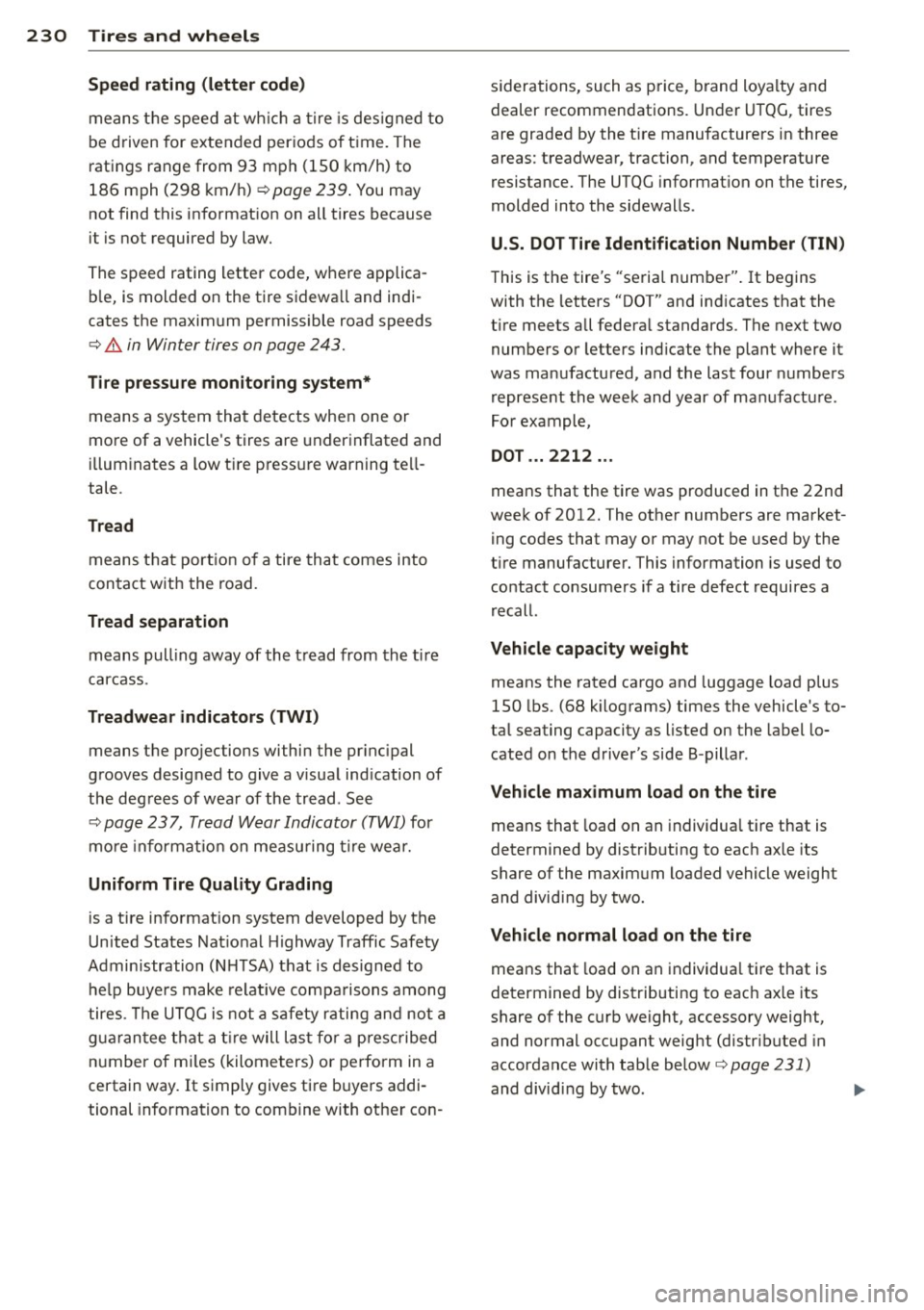
230 Tires and wheels
Speed rating (letter code)
means the speed at wh ic h a tir e is des igned to
be d riven for extended per io d s of t ime. The
ratings range from 93 mph (150 km/h) to
186 mph (298 km/h) ¢ page 239 . You may
not find this in format ion on all tires because
it is not required by law.
The speed rating letter code, w here a pplica
b le, is molded on the tire s idewa ll and indi
cates the maxim um permissible road speeds
¢ &. in Winter tires on page 243.
Tire pressure monitoring sy stem*
means a system tha t d etects when one or
mo re of a vehicle's t ires are under inflated and
i llum ina tes a low t ire p ress ure warn ing te ll
tale.
Tread
means t hat port ion of a tire tha t comes into
con tact w it h t he road.
Tread separation
means pull ing away of the t read from the t ire
car cass .
Treadwear indicators (TWI)
means t he projections withi n the pr inc ipal
g rooves designed to give a v isua l ind ication of
the deg rees of wea r of the tre ad . See
¢ pag e 23 7, Tread W ear Indicator (TWI) for
mo re inf ormat io n on measu ring tire we ar.
Uniform Tire Quality Grading
is a tire i nfo rmation system developed by the
United States Nat io nal Highway Traffic Safety
Admin istration (N HTSA) that is designed to
h e lp buye rs make re lative compa risons among
tires. The UT QG i s no t a safety r ating and no t a
g uar antee that a t ire will las t fo r a presc ribed
n umber of m iles (kilome ters) or pe rform in a
certain way. It s imply gives ti re bu ye rs addi
tional information to combine with other con -s
iderations, such as p rice , brand loya lty and
dealer recommendations. Un der UTQ G, tires
are grade d by the t ire manufacturers in three
areas : treadwea r, traction, and temperature
resistance. The UTQG informat ion on the tires,
molded into the sidewalls .
U.S. DOT Tire Identification Number (TIN )
This is the tire's "se ria l numbe r" . It be gins
with the letters "DOT" and ind icates that the
t ire meets all federa l standards . The next two
numbers or letters ind icate the plant where it
was ma nufactu red, and the last four numbe rs
r eprese nt the week and year of ma nufact ure.
Fo r exampl e,
DOT ... 2212 ...
means that the tire was produced in t he 22nd
wee k of 2012. The ot her numbers are market
ing codes that may or may not be used by the
t ire manufacturer. This information is used to
contact consumers i f a tire defect requires a
r ecall .
Vehicle capacity weight
means the rated cargo and luggage load plus
150 lbs. (68 k ilograms) times the vehicle's to
ta l seating capacity as listed on the label lo
cated on the driver's side B-pilla r.
Vehicle maximum lo ad on the tire
means that load on an individua l tire that is
determined by distributing to eac h axle its
share of the maxim um loaded vehicle weight
and divid ing by two .
Vehicle normal load on the tire
means that load on an individua l t ir e that is
determined by distributing to eac h ax le its
share of the curb weight, accessory weight,
and normal occ upant weig ht (d istr ibuted in
accorda nce wit h tab le below¢ page 231)
and divid ing by two .
Page 233 of 290
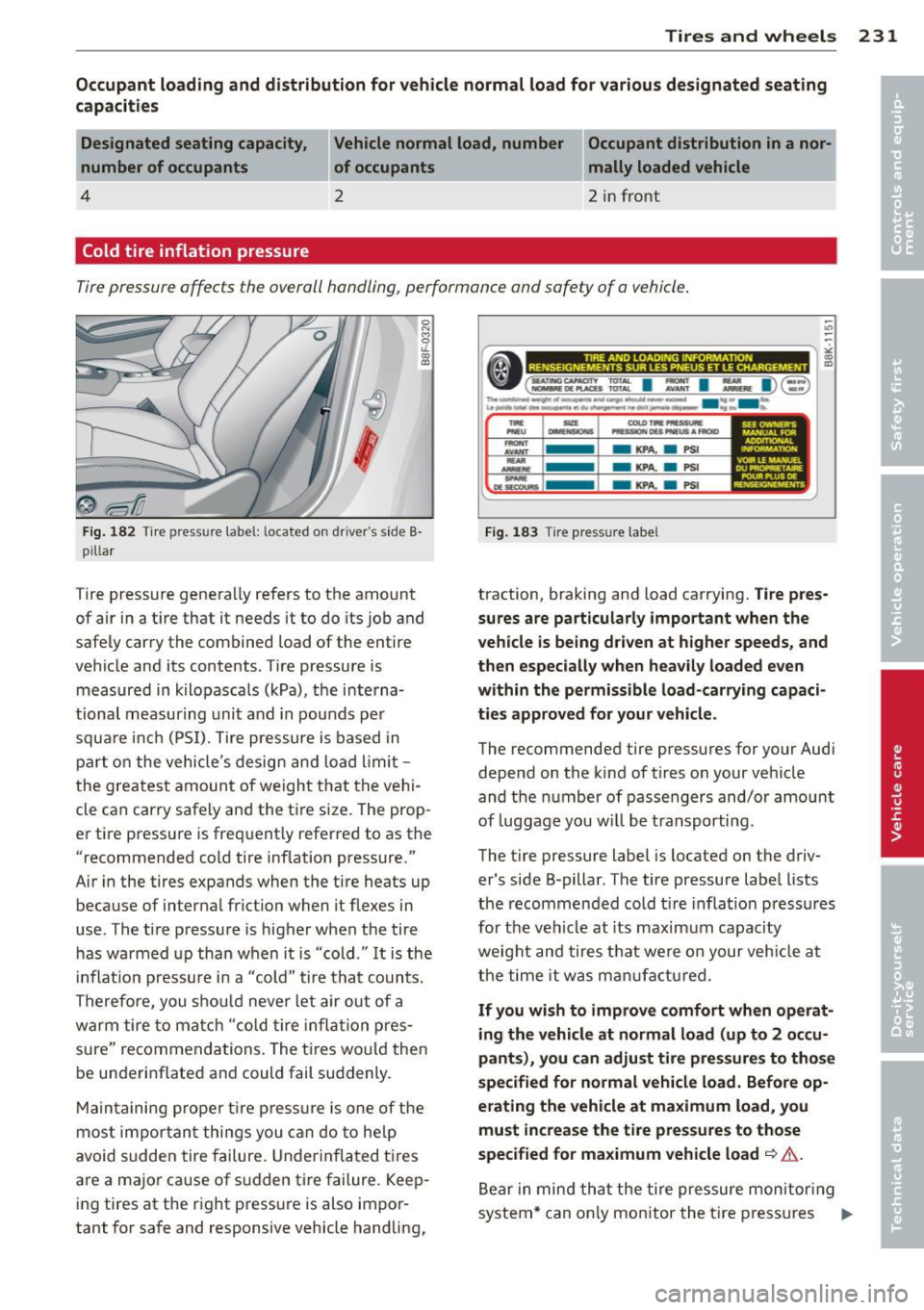
Tires and wheels 231
Occupant loading and distribution for vehicle normal load for various designated seating
capacities
Designated seating capacity,
number of occupants Vehicle normal load, number Occupant distribution in a nor-
of occupants
_____ mally loaded vehicle
4 2 2 in front
Cold tire inflation pressure
Tire pressure affects the overall handling, performance and safety of a vehicle.
Fig. 182 Tir e pressure labe l: located on driver 's s ide B·
p ill ar
Tire pressure generally refers to the amount
of air in a tire that it needs it to do its job and
safely carry the combined load of the entire
vehicle and its contents . Tire pressure is
measured in kilopasca ls (kPa), the interna
tional measuring unit and in pounds pe r
squa re inch (PSI). Tire pressure is based in
part on the vehicle's design and load limit -
the greatest amount of weight that the vehi
cle can carry safe ly and the t ire size . The prop
er tire pressure is frequent ly referred to as the
"recommended cold tire inflation pressure."
Air in the tires expands when the tire heats up
because of internal friction when it flexes in
use . The tire pressure is higher when the tire
has warmed up than when it is "cold ."
It is the
in flat ion pressure i n a "cold " tire that counts.
Therefore, you shou ld neve r let air out of a
warm tire to match "cold tire inflat ion pres
sure" recommendations. The tires would then
be underinflated and could fail suddenly.
Maintaining proper tir e pressure is one of the
most impor tant things you can do to help
avoid sudden tire failure. Underinflated tires
are a ma jor cause of s udden tire failure . Keep
ing tires at the right pressure is also impor
tant for safe and responsive vehicle handling,
-tD
-
---------------------.. ,;
•(==.: I :::; I :,,. I)@ gi n. ............ .,_____, .... -.ito._.. ____ .... _ ...
&..p0idit,101111-~--.,...,....-- ..... ~ .... ..
-··-.....
-
-Dlst<:OURS
- KPA.. a PSI
- KPA.. a PSI
- KPA.. a PSI
Fig. 183 Tire pressure labe l
traction, braking and load carrying. Tire pres
sures are particularly important when the
vehicle is being driven at higher speeds, and
then especially when heavily loaded even
within the permissible load-carrying capaci
ties approved for your vehicle.
The recommended tire pressures for your Audi
depend on the kind of tires on your ve hicle
and the number of passengers and/o r amount
of luggage you w ill be transporti ng.
The tire pressure label is located on the driv
er's side B -pillar . The tire pressure labe l lists
the recommended cold tire inflat io n pressures
for the vehicle at its maximum capacity
weight and tires that were on your veh icle at
t he time it was manufactured.
If you wish to improve comfort when operat
ing the vehicle at normal load (up to 2 occu
pants), you can adjust tire pressures to those
specified for normal vehicle load. Before op
erating the vehicle at maximum load, you
must increase the tire pressures to those
specified for maximum vehicle load
¢ &.
Bear in mind that the tire pressure monitoring
system * can only monitor the tire pressures
II>
Page 234 of 290
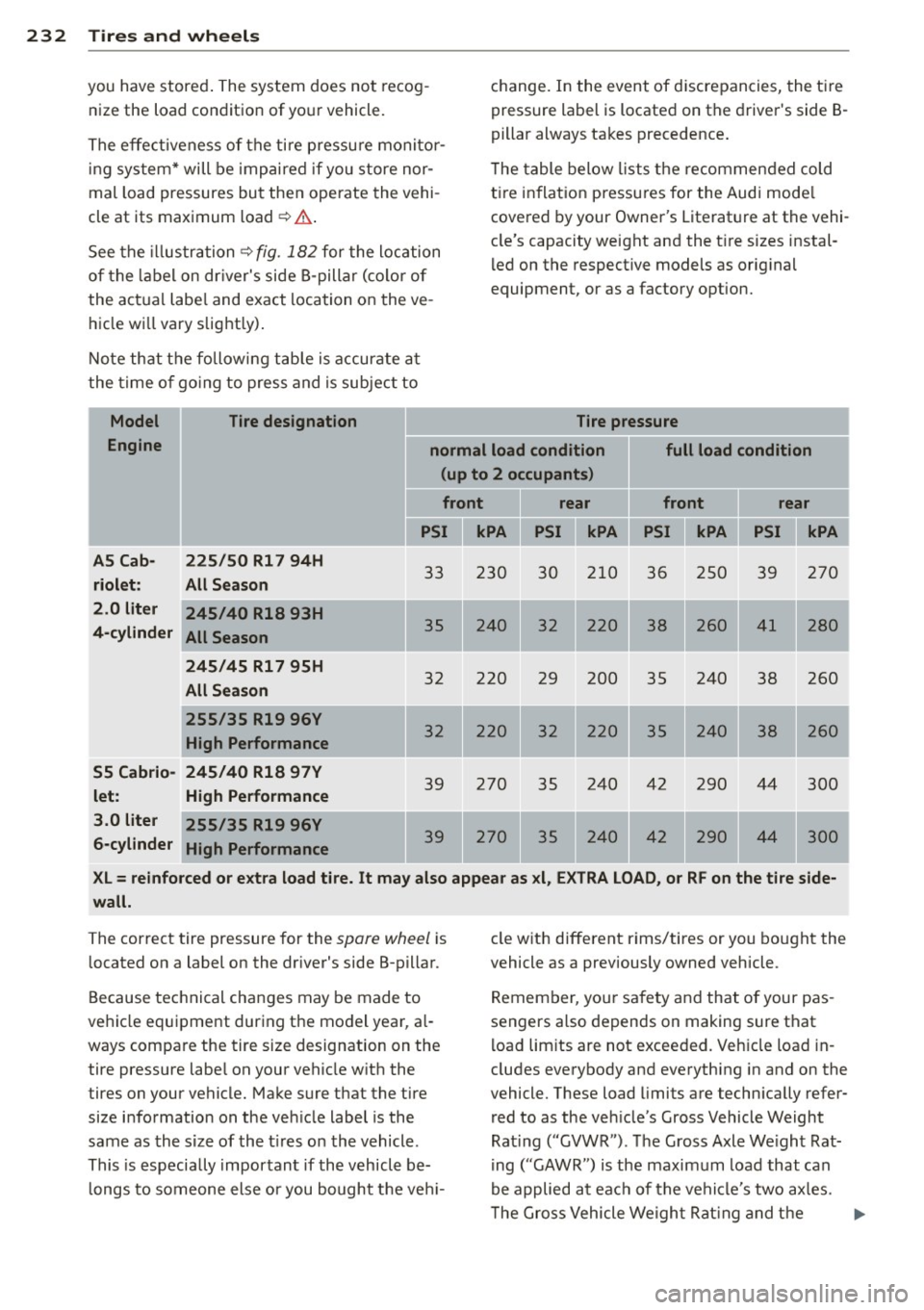
232 Tires and wheels
you have stored. The system does not recog
nize the load condition of your vehicle.
The effectiveness of the tire pressure monito r
ing system* will be impaired if you store nor
mal load pressures but then operate the vehi
cle at its maximum load¢.&. .
See the illustration¢
fig. 182 for the location
of the label on driver's side 8-pillar (color of
the actua l label and exact location on the ve
hicle wi ll vary slightly) .
Note that the following table is accurate at
the time of going to press and is subject to
Model Tire designation
change. In the event of discrepancies, the tir e
pressure label is located on the driver's side 8-
pillar always takes precedence.
T he table below lists the recommended cold
ti re inflation pressu res for the Audi mode l
covered by your Owner's Literature at the vehi
cle's capacity weight and the t ire sizes instal
l ed on the respective models as original
equipment, or as a factory option.
Tire pressure
Engine normal load condition full load condition
(up to 2 occupants)
front rear front rear
AS Cab- 225/50 Rl 7 94H
riolet: All Season
2.0 liter 24S/40 R18 93H
4-cylinder All Season
245/45 Rl 7 95H
All Season
255/35 R19 96V High Performance
55 Cabrio- 245/40 R18 97V
let: High Performance
3.0 liter
6-cylinder 255/35 R19 96V
High Performance PSI kPA PSI
33 230
30
35 240 32
32 220 29
32 220 32
39 270
35
39 270 35
kPA PSI kPA PSI kPA
210 36 250 39 270
220 38 260 41 280
200 35 240 38 260
'
220 35 240 38 260
I
240 42 290 44
300
.
240 42 290 44 300
I
XL= reinforced or extra load tire. It may also appear as xl, EXTRA LOAD, or RF on the tire side
wall.
The correct tire pressure for the spare wheel i s
located on a label on the driver's side 8-pillar.
Because technical changes may be made to
ve hicle equipment during the model year, al
ways compare the tire size designation on the
tire pressure labe l on your vehicle w ith the
tires on your vehicle. Make sure that the tire
size information on the veh icle label is the
same as the size of the tires on the vehicle.
This is especially important if the vehicle be
lo ngs to someone else or you bought the veh i- cle
with different rims/tires or you bought the
vehicle as a previously owned vehicle.
Remember, your safety and that of your pas
sengers also depends on making sure that
l oad lim its are not exceeded. Vehicle load in
cludes everybody and everything in and on the
vehicle. These load limits are techn ically refer
red to as the veh icle's Gross Vehicle Weight
Rating ("GVWR"). The Gross Axle Weight Rat
ing ("GAWR") is the maximum load that can
be applied at eac h of the vehicle's two axles .
T he Gross Vehicle Weight Rating and the .,.
Page 235 of 290
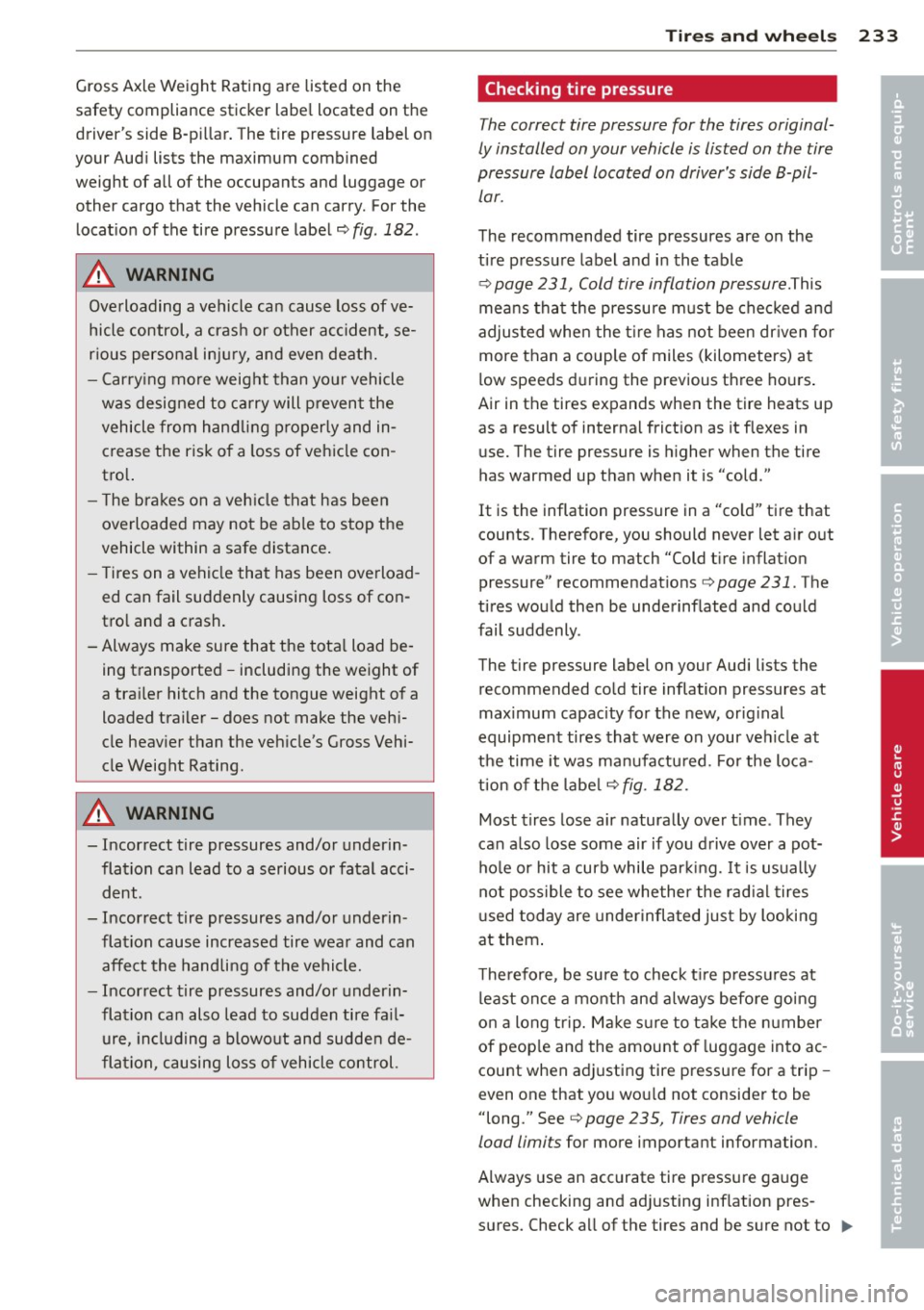
Gross Axle Weight Rating are listed on the
safety compliance sticker label located on the
driver's side B-pi llar . The tire pressure label on
your Aud i lists the maximum combined
weight of all of the occupants and luggage or
other cargo that the vehicle can carry . For the
locat io n of the tire pressure label¢
fig. 182 .
A WARNING
Overloading a vehicle can cause loss of ve
hicle control, a cras h or other accident, se
r ious personal inj ury, and eve n death.
- Carry ing more weight than yo ur vehicle
was designed to ca rry will p revent the
vehicle from hand ling properly and in
crease the risk of a loss of veh icle con
t ro l.
- T he bra kes on a veh icle that has bee n
overloaded may no t be a ble to stop the
vehicle within a safe distance .
- T ires on a vehicle that has been overload
ed can fail suddenly causing loss of con
tro l and a crash.
- Always make sure that the tota l load be
ing transported - including the weight of
a trai le r hitch and the tongue weight of a
loaded trailer -does not make the veh i
cle heav ier than the veh icle's Gross Vehi
cle Weight Rating .
A WARNING
- Incorrect tire pressures and/or underin
flation can lead to a serious o r fatal acci
dent .
- Incorrect tire pressures and/or underin
flation cause increased tire wea r and can
affect the handli ng of the vehicle.
- Incorrect tire pressures and/or underin
flation can also lead to sudden tire fa il
ure, including a blowo ut and sudde n de
fla tion, causing loss of vehicle control.
-
Tire s an d wheel s 233
Checking tire pressure
The correct tire pressure for the tires original
ly installed on your vehicle is listed on the tire
pressure label located on driver's side 8-pil
lar.
The recommended tire pressures are on the
ti re pressu re label and in the table
¢ page 231, Cold tire inflation pressure.This
mea ns tha t the pressu re m ust be chec ked and
adjus ted when the t ire has not been dr iven fo r
more than a couple of miles (kilometers) a t
low speeds d uring the previous three ho urs.
Air in the tires expands when the tire heats up
as a result of interna l frict ion as it flexes in
u se. The tire pressure is higher when the tire
has warmed up than whe n it is "cold ."
It is the inflation pressure in a "co ld" t ire that
counts. Therefore, you should never let a ir o ut
of a warm tire to match "Cold t ire inflat ion
pressure" recomme ndat io ns¢
page 231 . The
ti res wou ld then be unde rinflated and could
fail suddenly .
The t ire pressure label on your Audi lists the
recommended co ld tire inflation pressures at
max imum capac ity for the new, orig inal
equipment tires that were on your ve hicle at
the time it was ma nufactu red. For the lo ca
t ion of the labe l
¢fig. 182.
Most tires lose air natura lly ove r time . They
can a lso lose some air if you d rive over a pot
hole or hit a curb while par king.
It is usually
not po ss ible to see whethe r the rad ia l t ires
u sed today are underinflated just by loo king
at them .
T he refore, be sure to check t ire p ress ures at
l east once a mo nth and a lways befo re goi ng
on a long t rip. M ake s ure to ta ke the n umber
of peop le and the amount o f luggage into ac
count when adjusting tire pressure for a trip -
even one that yo u wou ld not conside r to be
"long." See ¢
page 2 3 5, Tires and vehicle
load limits
for mo re important information .
A lways use an acc urate tire pressure ga uge
when checking and ad justing inflation pres
s u res. Check a ll of the tires and be sure not to ..,. •
•
Page 236 of 290
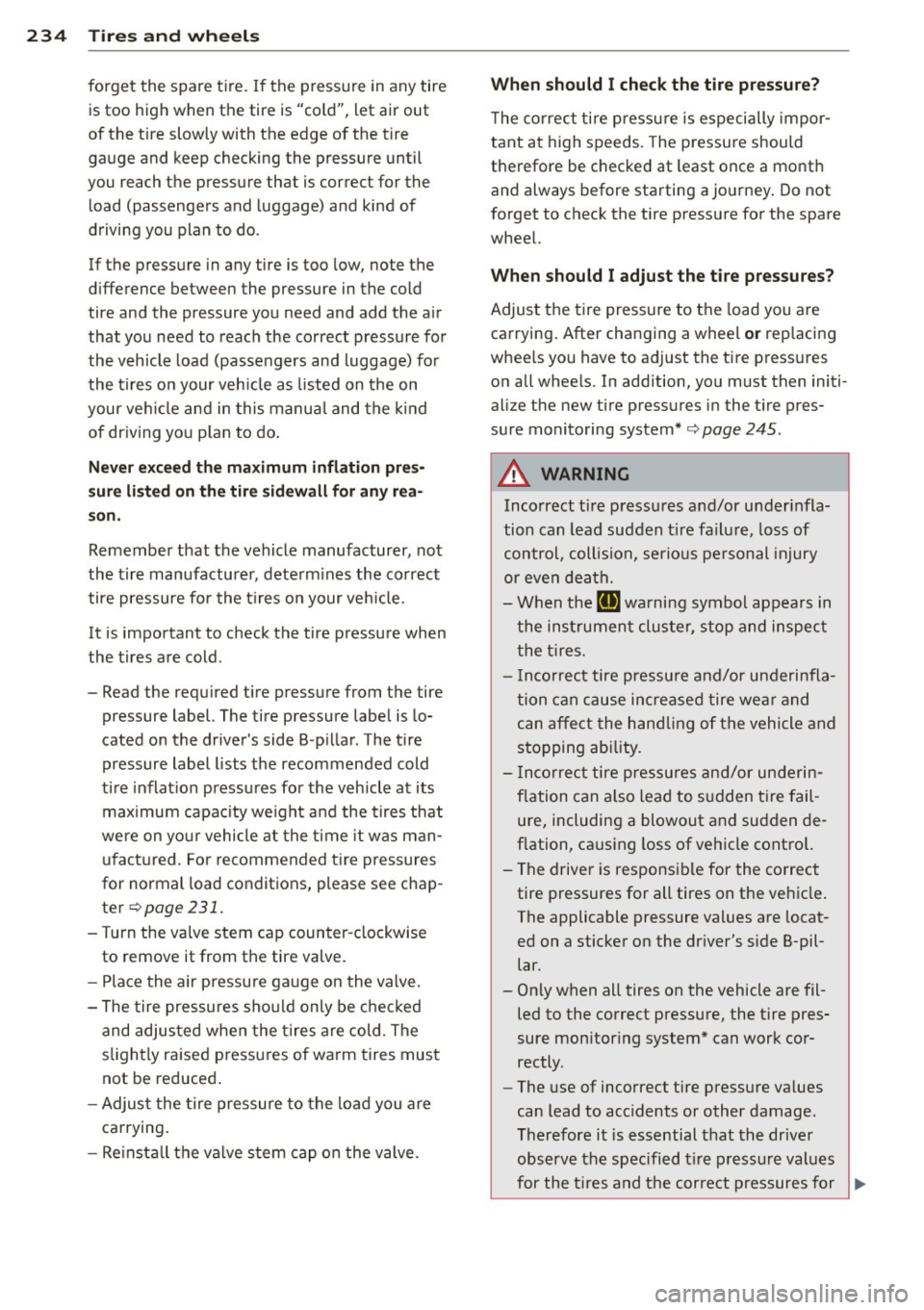
234 Tire s and wheel s
forget the spare tire. If the pressure in any tire
is too h igh when the tire is "cold", let air out
of the tire slowly with the edge of the tire
gauge and keep checking the pressure until
you reach the pressure that is correct for the
load (passengers and luggage) and kind of
driving you plan to do .
If the pressure in any tire is too low, note the
d ifference between the pressure in the cold
tire and the pressure you need and add the a ir
that you need to reach the correct pressure for
the vehicle load (passengers and luggage) for
the tires on your veh icle as listed on the on
your veh icle and in this manua l and the kind
of dr iving you p lan to do .
Never exceed th e ma ximum inflati on pres
s ur e list e d on th e tir e s idewall f or an y re a
so n.
Remembe r that the vehicle manufacturer, not
the tire manufactu rer , determ ines the correct
tire pressure for the t ires on your vehicle .
It is important to check the tire pressure when
the tires a re cold .
- Read the requ ired t ire pre ssure from the tire
pressure label. The tire pressure label is lo
cated on the driver's side 8 -p ill ar . The tire
pressure label lists the recommended cold
t ire inflat ion pressures for the vehicle at its
maximum capacity we ight a nd the tires that
were on yo ur vehicle at the time it was man
u factured. Fo r recommended tire press ures
for normal load conditions, please see chap
ter
¢ page 231 .
-Turn the valve stem cap counter-clockwise
to remove it from the tire valve.
- Place the air pressure gauge on the valve.
- The tire pressures should only be chec ked
and adjus ted when the tires are cold . The
s li ghtly raised pressures of warm tires must
not be reduced .
- Adjust the tire pressure to the load you are
carrying .
- Re insta ll the va lve stem cap o n the valve .
When should I check th e tir e pre ssure ?
The correct tire pressu re is especially impor
tant at high speeds. The pressu re should
therefore be checked at least once a month
and always before starting a jo urney . Do not
forget to check the tire pressure for the spare
wheel.
When should I adju st the ti re pre ssures?
Adjust the tire pressure to the load you are
carrying . After changing a whee l
or replacing
whee ls you have to adjust the tir e pressur es
on all wheels. In addition, you m ust then initi
a lize the new tire pressures in the t ire pres
sure monitoring system*¢
page 245.
A WARNING
-Incorrect tire pressures and/or underinfla-
tion can lead sudden tire fa ilure, loss of
control, collision, se rious pe rsonal injury
or even dea th.
- When the
[IJ wa rning symbol appears in
the instrument cluster, stop and inspect
the t ires.
- Inco rrect tire pressure and/or underinfla
tion can cause increased tire wea r and
can affect the handling of the vehicle and
stopping abi lity.
- Incorrec t tire pressures and/or underin
flation can a lso lead to s udden t ire fail
ure, including a blowout and sudden de
flation, ca using loss of vehicle contro l.
- The driver is responsible for the correct
tire pressures for all tires on the vehicle .
The applicable pressure values are locat
ed on a sticker on the dr iver's s ide 8-pil
lar.
- Only when all tires on the vehicle are fil
led to the correct pressure, the t ire pres
sure mon itor ing system* can work cor
rectly .
- The use of incorrect tire pressure values
can lead to acc idents or other damage .
Therefore it is essential that the drive r
observe the spec ified t ire pressu re val ues
for the tires and the correct pressures for
II),
Page 237 of 290
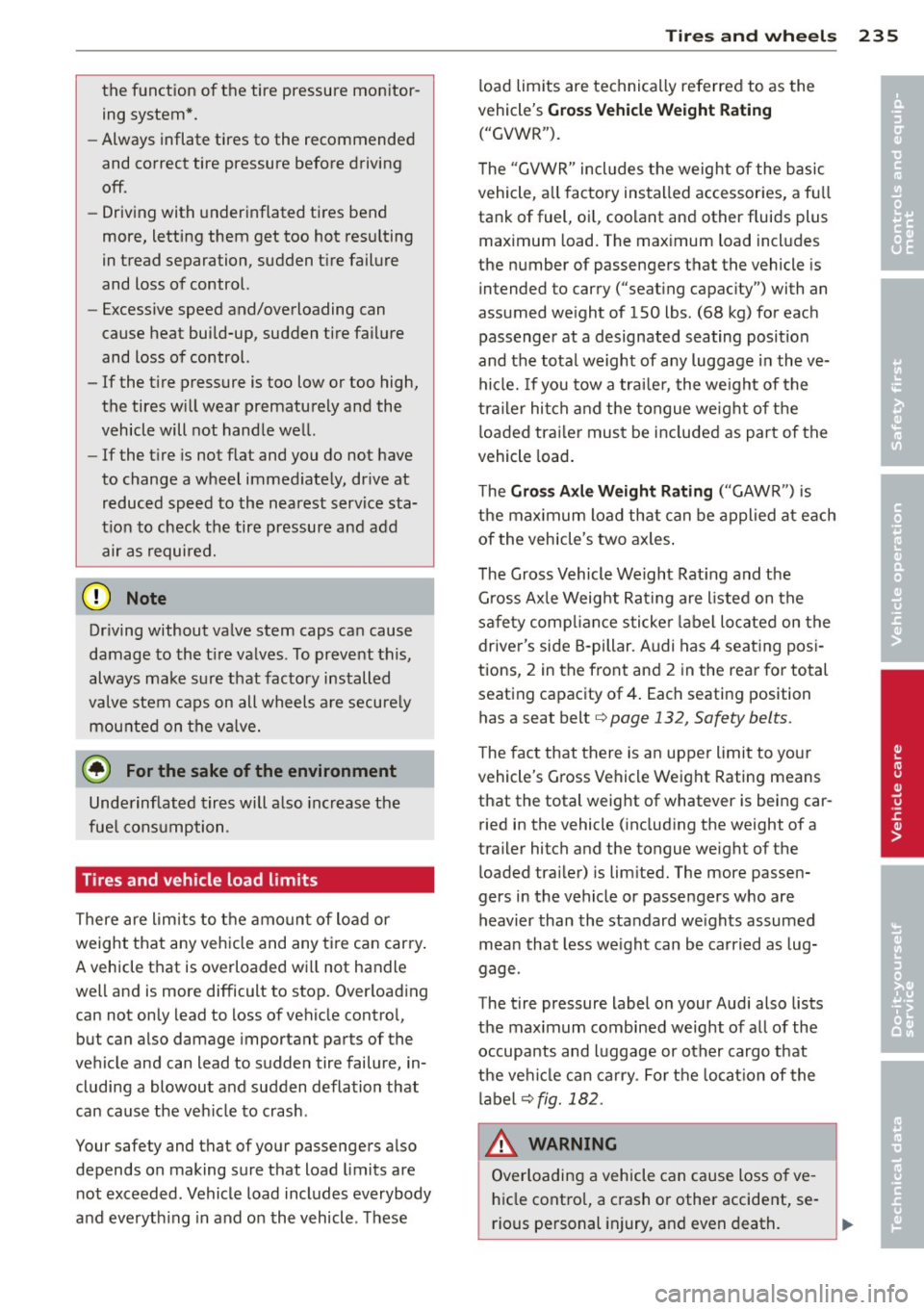
th e f unct ion of the tire pressure monitor
ing system*.
- Always inflate tires to the recommended
and correct tire pressure before driving
off.
- Driving with under inflated tires bend
more, letting them get too hot resu lting
in tread separation, sudden t ire failure
and loss of control.
- Excessive speed and/overloading can
cause heat build-up, sudden tire fail ure
and loss of control.
- If the t ire pressure is too low or too high,
the tires w ill wea r prematurely and the
vehicle will not hand le we ll.
- If the t i re is not flat and you do not have
to change a w heel immed iate ly, dr ive at
reduced speed to the nearest serv ice sta
t ion to check the tire pressure and add
air as requi red.
{Q) Note
Dr iving without va lve stem caps ca n cause
damage to the tire va lves . To preve nt this,
always ma ke s ure t hat facto ry installed
va lve stem caps on all wheels a re secu re ly
mounte d on the va lve.
@ For the sake of the environment
Unde rinflat ed tires will a lso inc reas e the
fue l cons umption .
Tires and vehicle load limits
There are l imits to the amo un t of load or
weight that any vehicle and any tire can carry .
A veh icle that is overloaded w ill not handle
w ell and is more difficult to stop. Overload ing
can not only lead to loss of vehicle contro l,
but c an a lso damage import ant parts of the
ve hicle and can lead to sudden tire failure, in
cluding a blowout and sudden deflation that
can cause the ve hicle to crash .
Your safety and that of your passengers a lso
depends on making sure that load limits are n ot exceeded. Vehicle load includes everybody
and everyth ing in and on the vehicle . Th ese
Tire s an d wheel s 235
load lim its are technically referred to as the
vehicle's
Gross Vehicle Weight Rating
("GVWR").
T he "GVWR" incl udes the weight of the basic
vehicle, a ll factory installed accessories, a f ull
tan k of fuel, oi l, coo lant and other fluids plus
max imum load. The max imum load incl udes
the n umber of passengers t hat the vehicle is
intended to carry ("seat ing capac ity") with an
ass umed we ight of 150 lbs . (68 kg) for eac h
passenger at a designated seating posi tion
and the tota l weight of a ny luggage i n the ve
hicle. If you tow a tra ile r, the we igh t of the
tra iler hi tch and the tongue we igh t of t he
loaded tra iler mus t be included as part of the
vehicle load .
T he
Gro ss Axle Weight Rating (" G AWR ") is
the max imum load th at can be appl ied a t each
of the veh icle's two axles .
T he Gross Vehicle Weight Rat ing and t he
G ross Ax le Weig ht Ra ting are listed on the
sa fe ty comp lian ce sti cke r la bel lo cate d on the
driver's side B-pillar. Audi has
4 seating pos i
tions, 2 in the front an d 2 in the rear fo r total
seating capacity of 4 . Eac h seati ng position
has a seat belt
q page 132, Safety belts.
T he fac t that there is an upper limit to yo ur
vehicle's Gross Vehicle Weight Rating means
that the total weight of whatever is being car ried in the vehicle ( includ ing the weight of a
trailer hitch and the tongue weight of the
loaded tra iler) is lim ited. The more passen
gers in the vehicle or passengers w ho are
heavier than the sta ndard we ights assumed
mea n that less we ight can be ca rried as lug
gage.
T he tire pressure label on your Audi also lists
the max imum combined weight of all of the
occupants and l uggage or other cargo that
the ve hicl e can ca rry . Fo r th e lo cat ion of the
la bel
q fig. 182 .
_&. WARNING
--==
Overloading a vehicle can cause loss o f ve -
h icle cont ro l, a crash or other accide nt, se-
rious pe rsonal in ju ry, and even death. ..,
•
•
Page 238 of 290
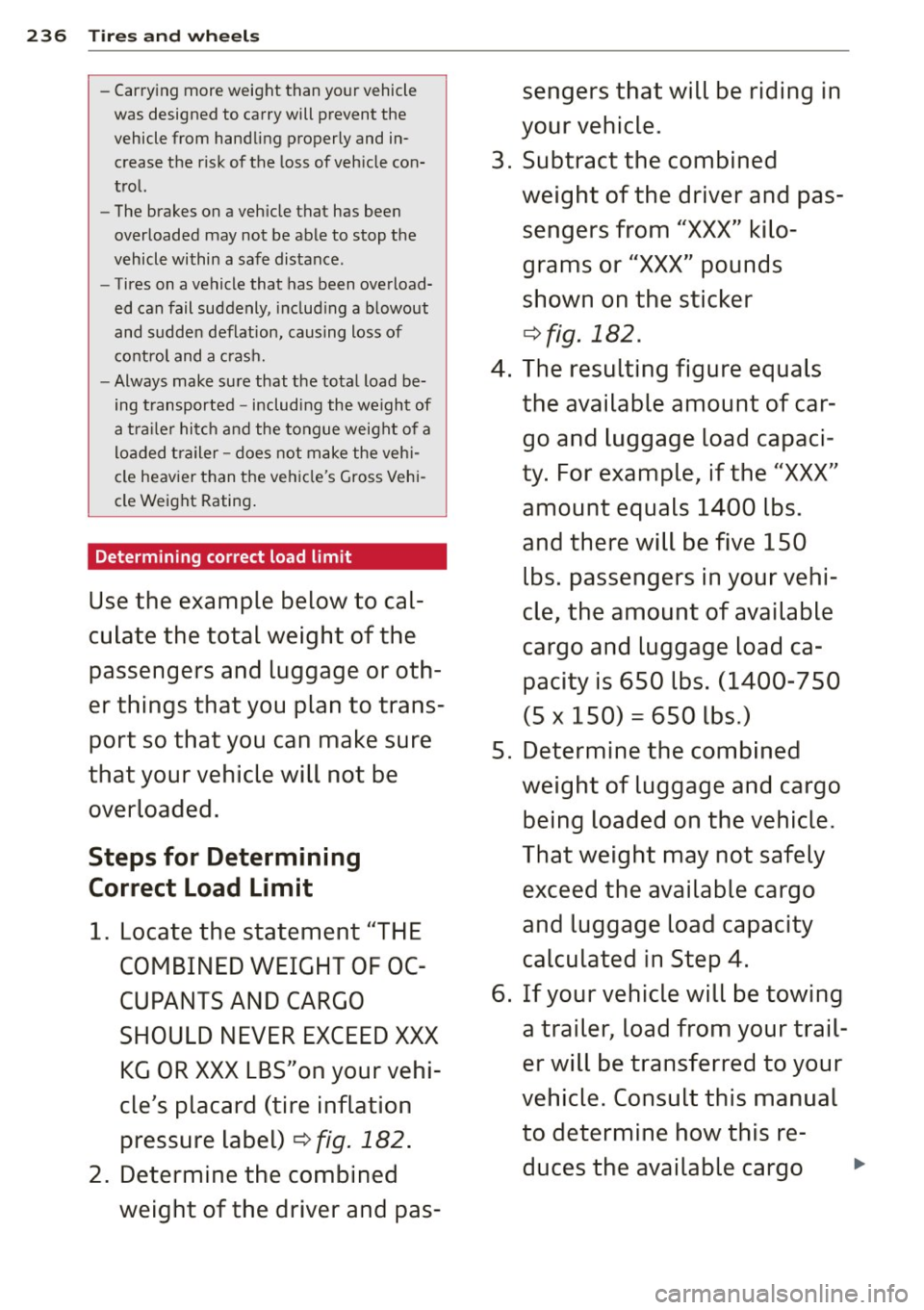
236 Tires and wheels
-Carrying more weight than your vehicle
was designed to carry will prevent the
vehicle from handling properly and in
crease the risk of the loss of vehicle con
trol.
- The brakes on a vehicle that has been
overloaded may not be able to stop the
vehicle within a safe distance.
- Tires on a vehicle that has been overload
ed can fail suddenly, including a blowout
and sudden deflation, causing loss of
control and a crash.
- Always make sure that the total load be
ing transported -including the weight of
a trailer hitch and the tongue weight of a
loaded trailer - does not make the vehi
cle heavier than the vehicle's Gross Vehi
cle Weight Rating.
Determining correct load limit
Use the example below to cal
culate the total weight of the
passengers and luggage or oth
er things that you plan to trans
port so that you can make sure
that your vehicle will not be
overloaded.
Steps for Determining Correct Load Limit
1. Locate the statement "THE
COMBINED WEIGHT OF OC
CUPANTS AND CARGO
SHOULD NEVER EXCEED XXX KG OR XXX LBS"on your vehi
cle's placard (tire inflation pressure label)
¢fig. 182.
2. Determine the combined weight of the driver and pas- sengers that will be riding in
your vehicle.
3. Subtract the combined weight of the driver and passengers from
"XXX" kilo
grams or
"XXX" pounds
shown on the sticker
¢fig. 182.
4. The resulting figure equals the available amount of car
go and luggage load capaci
ty. For example, if the
"XXX"
amount equals 1400 lbs.
and there will be five 150
lbs. passengers in your vehi
cle, the amount of available
cargo and luggage load ca
pacity is 650 lbs. (1400-7 SO
(5
X 150) = 650 lbs.)
5. Determine the combined weight of luggage and cargo
being loaded on the vehicle.
That weight may not safely exceed the available cargo
and luggage load capacity
calculated in Step 4.
6. If your vehicle will be towing a trailer, load from your trail
er will be transferred to your
vehicle. Consult this manual
to determine how this re duces the available cargo
Page 239 of 290
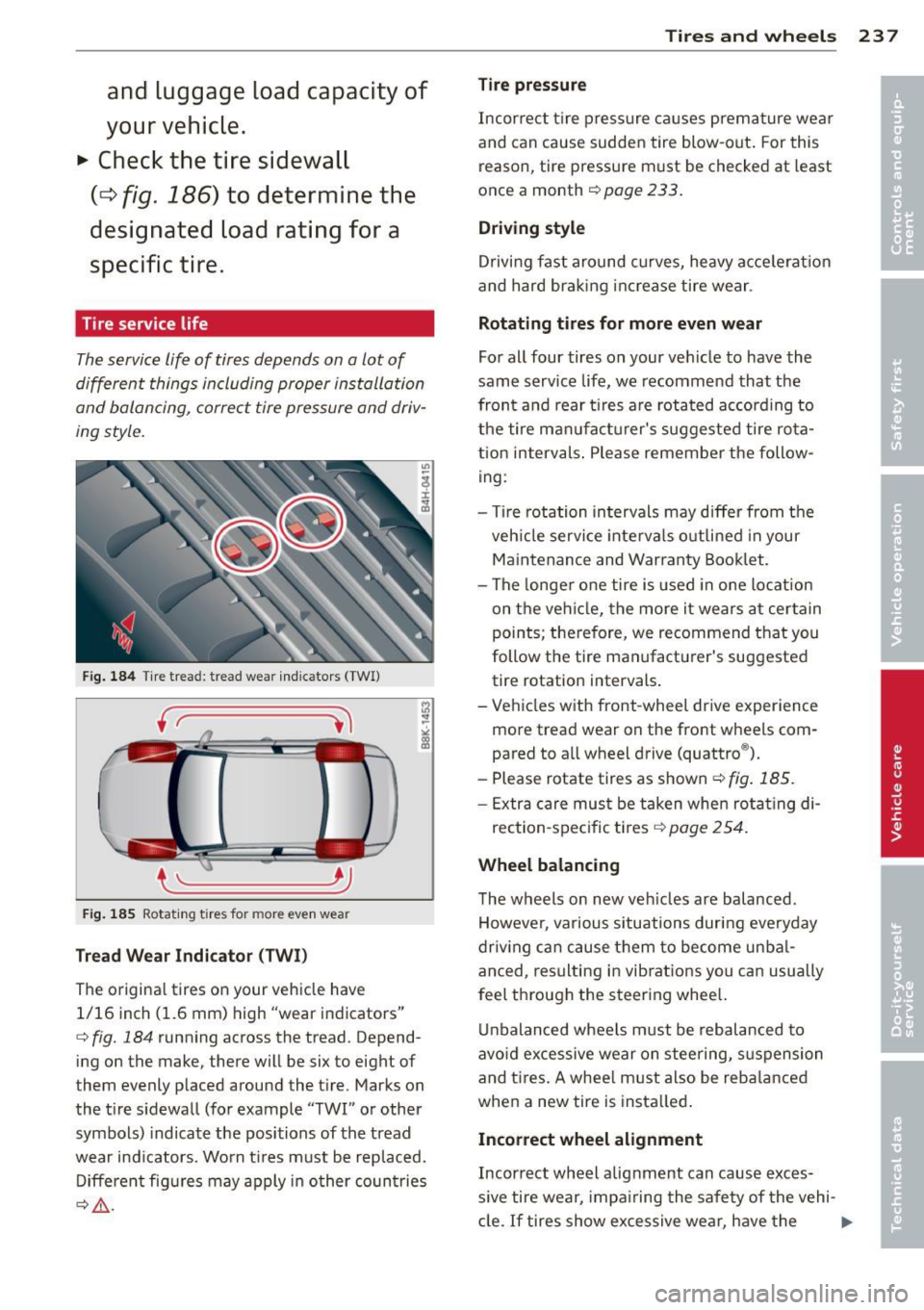
and luggag e load c apaci ty of
y our vehicle.
.,. Check the tire sidewall
(c:::> fig . 18 6) to d etermine th e
de sign ated load rating f or a
s p ecific tir e.
Tire service life
The service life of tires depends on a lot of
different things including proper installation
and balan cing , correc t tire pressure and driv
ing style.
Fi g. 1 84 Tire t rea d: tread we ar ind ic a tors (TWI)
.__ __ __,, ,.)
Fig . 185 Rotat ing t ires for more eve n wea r
Tread Wear Indicator (TWI)
The origina l tires on your vehicle have
1/16 inch (1.6 mm) high "wear indicators"
<=> fig. 184 running across the tread. Depend
ing on the make, there will be six to eight of
t hem evenly p laced around the t ire. Marks on
the t ire s idewall (for example ''TWI " or other
symbols) indicate the positions of the tread
wear ind icators . Worn t ires m ust be replaced.
D ifferen t fig ures may apply in o ther co untries
¢ ,& .
Tires and wheels 23 7
Tire pressure
Incorrect tire press ure c auses prema ture wear
and can cause sudden tire blow-out . For this
reason , tire pressure must be checked at least
once a month
r:!) page 233.
Driving style
Driving fast around c urves, heavy acce le ra ti on
and har d brak ing inc rease tire wear .
Rotating tires for more even w ear
For all four tires on your vehicle to have the
same service life , we recommend that the
front and rear t ires a re rotated a ccording to
the tire man ufactur er's suggested tire ro ta
tion intervals . Please remember the follow
ing:
- Tire rotation in tervals may differ from the
veh icle servi ce inte rv al s o utli ned in your
Ma intenance and Warranty Boo klet.
- The longer one tire is used in one lo cation
on t he veh icle, the more it wears a t cer tain
points ; the re fore, we recommend that you
follow the tire man ufact urer's suggested
tire rotation intervals .
- Vehi cles w ith front-wheel dr ive experience
more tread wear on the front wheels com
pared to a ll wheel drive (quattro ®).
- Please rotate tires as shown¢
fig. 185 .
-Extra care mus t be taken when ro ta ti ng di -
rection -specific tires
q page 2 54.
Wheel balancing
T he w heels on new ve hicles are balanced .
Howeve r, various s ituations duri ng eve ryday
driv ing ca n ca use t hem to become unba l
anced, resulting in vib rat ions you ca n usually
feel through the steer ing whee l.
Un balanced wheels must be rebalanced to
avo id excessive wear on steering, s uspension
and t ires. A whee l m ust also be reba lanced
when a new tire is insta lled .
Incorrect wheel alignment
Incor rect wheel alignment can cause exc es
s ive tire wear, impa iring the safe ty of the vehi-
cle. If tires show excessive wear, have the
)I>-
Page 240 of 290
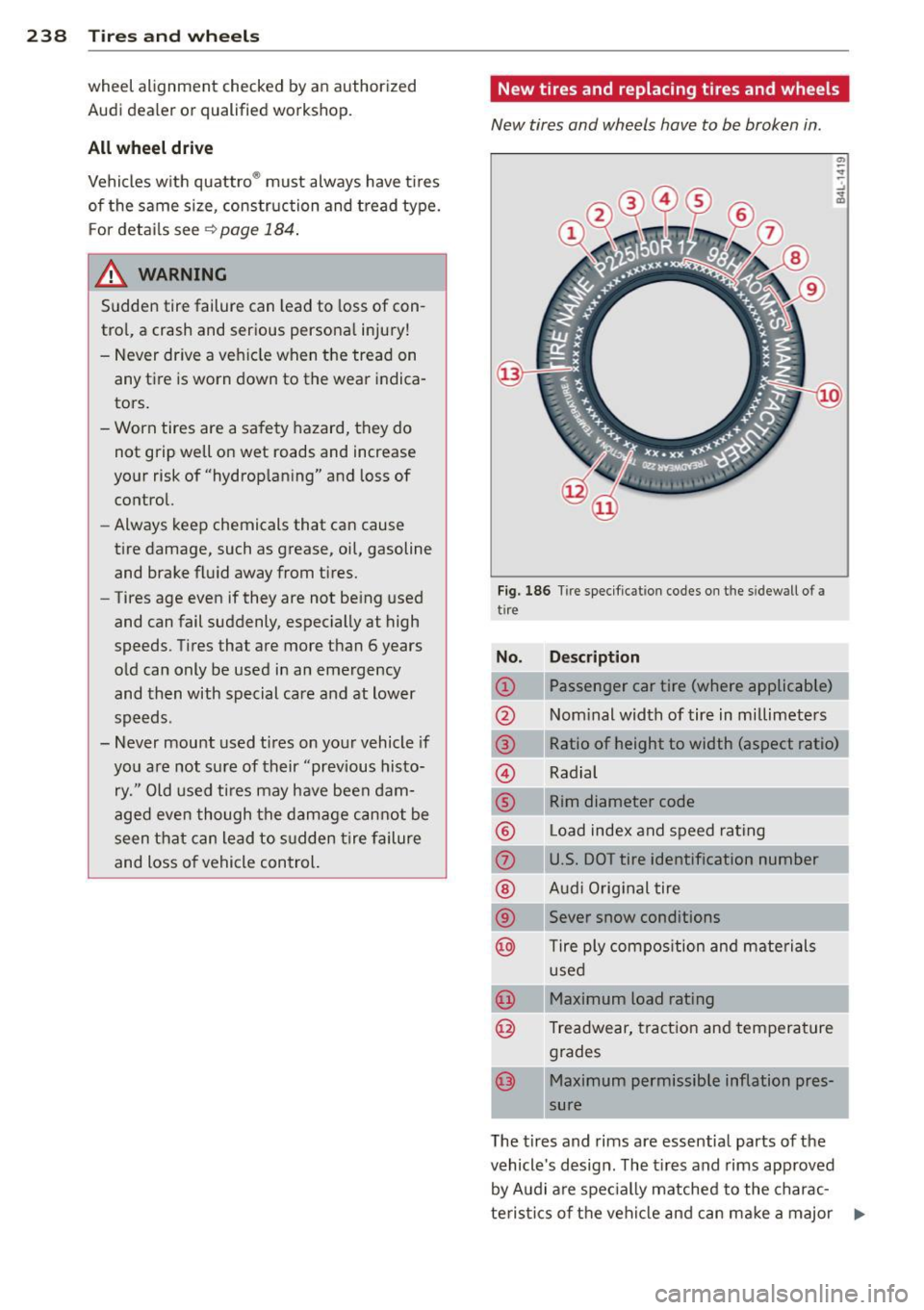
238 Tires and w hee ls
wheel alignment checked by an authorized
Audi dealer or qualified workshop.
All wheel dri ve
Vehicles w ith quattro ® must always have tires
of the same size, construction and tread type. F or detai ls see
¢ page 184 .
.8, WARNING
Sudden tire failure can lead to loss of con
trol, a crash and serious personal injury!
- Never drive a veh icle when the tread on
any tire is worn down to the wear indica
tors.
- Worn tires are a safety hazard, they do not grip well on wet roads and increase
your risk of "hydrop lan ing" and loss of
control.
- Always keep chemicals that can cause
tire damage, such as grease, oil, gasoline
and brake fluid away from tires.
- Tires age even if they are not being used
and can fail suddenly, especially at high
speeds. Tires that are more than 6 years
old can only be used in an emergency
and then with special care and at lower
speeds.
- Never mount used tires on your vehicle if
you are not sure of their "previous histo
ry." Old used tires may have been dam
aged even though the damage cannot be
seen that can lead to s udden tire failure
and loss of vehicle control.
New tires and replacing tires and wheels
New tires and wheels have to be broken in .
Fig. 186 Tir e specificat ion c odes on t he s idewall o f a
t ire
N o. Descri ption
(!) Passenger car tire (where applicable)
@ Nom inal width of tire in millimeters
@ Ratio of height to width (aspect ratio)
© Radial
® Rim diameter code
@ L oad index and speed rating
(J) U.S. DOT tire identification number
@ Audi Orig inal tire
@ Sever snow conditions
@ Tire ply compos ition and mate rials
used
Maximum load rating
Treadwear, traction and temperature
grades
Maximum permissible inflation pres
sure
T he t ires and rims are essential parts of the
vehicle 's design . The tires and rims approved
by Audi are spec ially matched to the charac
teristics of the vehicle and can make a major .,..